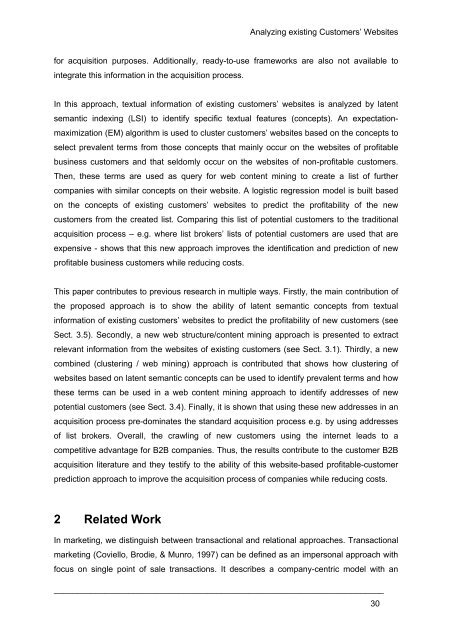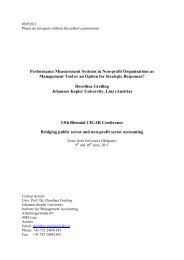ESSAYS ON TEXT MINING FOR IMPROVED DECISION MAKING ...
ESSAYS ON TEXT MINING FOR IMPROVED DECISION MAKING ...
ESSAYS ON TEXT MINING FOR IMPROVED DECISION MAKING ...
Create successful ePaper yourself
Turn your PDF publications into a flip-book with our unique Google optimized e-Paper software.
Analyzing existing Customers’ Websites<br />
for acquisition purposes. Additionally, ready-to-use frameworks are also not available to<br />
integrate this information in the acquisition process.<br />
In this approach, textual information of existing customers’ websites is analyzed by latent<br />
semantic indexing (LSI) to identify specific textual features (concepts). An expectationmaximization<br />
(EM) algorithm is used to cluster customers’ websites based on the concepts to<br />
select prevalent terms from those concepts that mainly occur on the websites of profitable<br />
business customers and that seldomly occur on the websites of non-profitable customers.<br />
Then, these terms are used as query for web content mining to create a list of further<br />
companies with similar concepts on their website. A logistic regression model is built based<br />
on the concepts of existing customers’ websites to predict the profitability of the new<br />
customers from the created list. Comparing this list of potential customers to the traditional<br />
acquisition process – e.g. where list brokers’ lists of potential customers are used that are<br />
expensive - shows that this new approach improves the identification and prediction of new<br />
profitable business customers while reducing costs.<br />
This paper contributes to previous research in multiple ways. Firstly, the main contribution of<br />
the proposed approach is to show the ability of latent semantic concepts from textual<br />
information of existing customers’ websites to predict the profitability of new customers (see<br />
Sect. 3.5). Secondly, a new web structure/content mining approach is presented to extract<br />
relevant information from the websites of existing customers (see Sect. 3.1). Thirdly, a new<br />
combined (clustering / web mining) approach is contributed that shows how clustering of<br />
websites based on latent semantic concepts can be used to identify prevalent terms and how<br />
these terms can be used in a web content mining approach to identify addresses of new<br />
potential customers (see Sect. 3.4). Finally, it is shown that using these new addresses in an<br />
acquisition process pre-dominates the standard acquisition process e.g. by using addresses<br />
of list brokers. Overall, the crawling of new customers using the internet leads to a<br />
competitive advantage for B2B companies. Thus, the results contribute to the customer B2B<br />
acquisition literature and they testify to the ability of this website-based profitable-customer<br />
prediction approach to improve the acquisition process of companies while reducing costs.<br />
2 Related Work<br />
In marketing, we distinguish between transactional and relational approaches. Transactional<br />
marketing (Coviello, Brodie, & Munro, 1997) can be defined as an impersonal approach with<br />
focus on single point of sale transactions. It describes a company-centric model with an<br />
_______________________________________________________________________<br />
30

















